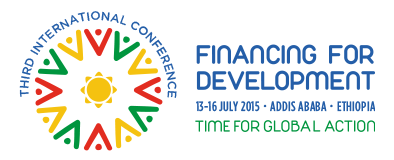On the Third International Conference on Financing for Development (FfD 3) blog, experts have identified deliverables and policy recommendations that the FfD 3 could provide.
Recent blog posts are authored by experts from the Overseas Development Institute (ODI), the Bill & Melinda Gates Foundation, the Global Partnership for Education, the Food and Agriculture Organization of the UN (FAO) and the Agence Française de Développement Group (AFD).
 30 June 2015: On the Third International Conference on Financing for Development (FfD 3) blog, experts have identified deliverables and policy recommendations that the FfD 3 could provide. Recent blog posts are authored by experts from the Overseas Development Institute (ODI), the Bill & Melinda Gates Foundation, the Global Partnership for Education, the Food and Agriculture Organization of the UN (FAO) and the Agence Française de Développement Group (AFD).
30 June 2015: On the Third International Conference on Financing for Development (FfD 3) blog, experts have identified deliverables and policy recommendations that the FfD 3 could provide. Recent blog posts are authored by experts from the Overseas Development Institute (ODI), the Bill & Melinda Gates Foundation, the Global Partnership for Education, the Food and Agriculture Organization of the UN (FAO) and the Agence Française de Développement Group (AFD).
Kevin Watkins, ODI Executive Director, identifies “five winning tickets” that FfD 3 could offer: social floors; aid, especially for the least developed countries (LDCs); climate finance; infrastructure; and redirected wasted resources for sustainable development. On social floors, he calls for countries to unite their efforts to help the most marginalized, explaining that even with an enhanced revenue effort, the world’s poorest countries will be unable to finance universal health coverage (UHC), basic education and social protection.
On aid, he suggests that governments reaffirm the 0.7 % aid target and deliver a clear commitment to provide half of all aid to LDCs. On climate finance, he urges developed countries to set clear and transparent benchmarks for delivering the US$100 billion in climate finance pledged for 2020. On infrastructure, he proposes removing infrastructure financing bottlenecks through other official flows beyond aid, such as risk guarantees to private sector investors and lending from the World Bank and regional development banks. On redirecting wasted resources to sustainable development, he calls for dates and practical commitments, such as a pledge by countries to eliminate the US$88 billion now allocated to discovering and exploiting new reserves of “unburnable carbon.”
Johannes Kiess, Gates Foundation, writes about local capacity as “the lynchpin” for creating investment opportunities at scale. He identifies two main impediments to making private capital a complement to public investment in basic needs: the mismatch between features of investment products and requirements of different types of investors; and insufficent local capacity to create and promote investment opportunities and package bankable deals. Kiess explains that countries need support in building local institutions that can: provide financial advisory to build investment pipelines, structure and execute transactions; bring together co-financing from public and private sources (blending); and bring opportunities to scale through pooled funding.
He stresses the need to work together to build local teams that understand: project development within the local context; investor requirements; and use of credit enhancement instruments, adding that standardization can help reduce transaction costs, increase transparency, and make it easier to understand investment opportunities as there is currently too much uncertainty about asset classes and risk assessments.
Julia Gillard, Global Partnership for Education, notes that donor aid to basic education in developing countries has dropped by 7% between 2010 and 2013, even though overall development aid increased by more than 9% over the same period. Although traditional donors will need to increase efforts, she stresses the need to “tap new sources,” such as the private sector, the philanthropic world and entrepreneurs. She adds that simply getting more money is not enough, but education funding needs to be spent efficiently, to focus on the greatest needs, and base spending on good policies and reliable data.
Jomo Sundaram, FAO, writes that the FfD 3 agreement has to recognize the broader responsibilities implied by the post-2015 development agenda, “summed up by the concept of common but differentiated responsibility (CBDR).” He stresses the need for: establishing predictable and equitable mechanisms out of debt distress for developing countries; more effective cooperative actions against illicit capital flows and tax evasion; and installing a “true” partnership between developed and developing countries through aid programmes that genuinely respond to national priorities and avoid “unreasonable” donor conditionalities. The FfD 3 outcome should also improve the voices of all developing countries in policymaking in the institutions of global economic governance, he adds.
Yves Guicquéro, AFD, identifies priorities for Official Development Assistance (ODA): continuing to earmark a substantial proportion of international aid for the development of the poorest and most vulnerable countries, in the form of grants and highly concessional loans; supporting public policies, assist local actors and catalyze other sources of financing in order to generate powerful leverage effects on investment; and supporting public policies focused on the SDGs. He further stresses the need to place local actors at the center of development, and adds that international partners must provide “massive support” to local authorities, as municipalities are increasingly responsible for policies for providing basic services.
The FfD 3 will take place on 13-16 July 2015, in Addis Ababa, Ethiopia. [FfD 3 Blog] [FfD 3 Website]